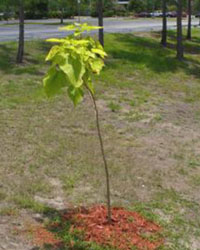Catalpa bignonioides - Southern catalpa



Family Bignoniaceae
Description:
About eleven species of Catalpa are native to North America, the Caribbean and eastern Asia. All are large trees. Some are used for timber. The southern catalpa is native to the southeastern United States. It is a large, spreading, deciduous tree to about fifty feet tall. Leaves are large and somewhat heart-shaped. Flowers are white with purple spots in the throat, about 1 ½ inch across, and held on long spikes. Fruits are long, dry cylinders filled with papery seeds that are distributed by wind. Fishing enthusiasts know catalpa as the source of the catalpa (or catawba) worm, a popular fish bait. The catalpa worm is the caterpillar of the catalpa sphinx moth. The wood is relatively soft and has been used for posts, cross ties, and cabinetry. Native Americans used catalpa to treat a variety of ailments.
Location:
See this plant at University Center.
Size:
A large tree to about fifty feet tall.
Care Instructions:
Light: full sun
Water: moist soils, somewhat drought tolerant
Soil: no special requirements
In the wild, southern catalpa is usually found in low ground but not in swamps. It is fairly drought tolerant once established. It is easy to grow in Jacksonville.
